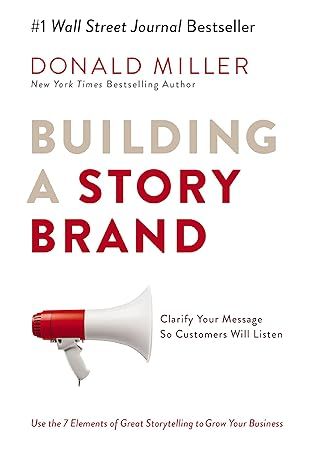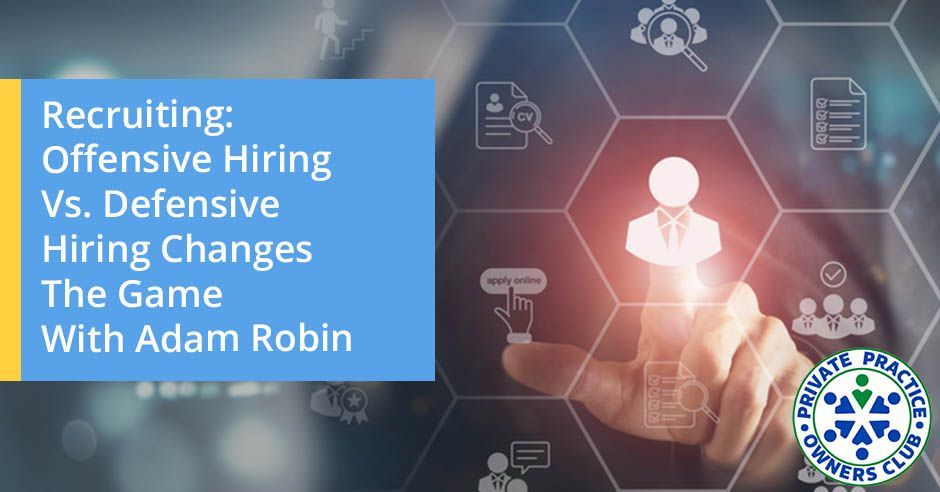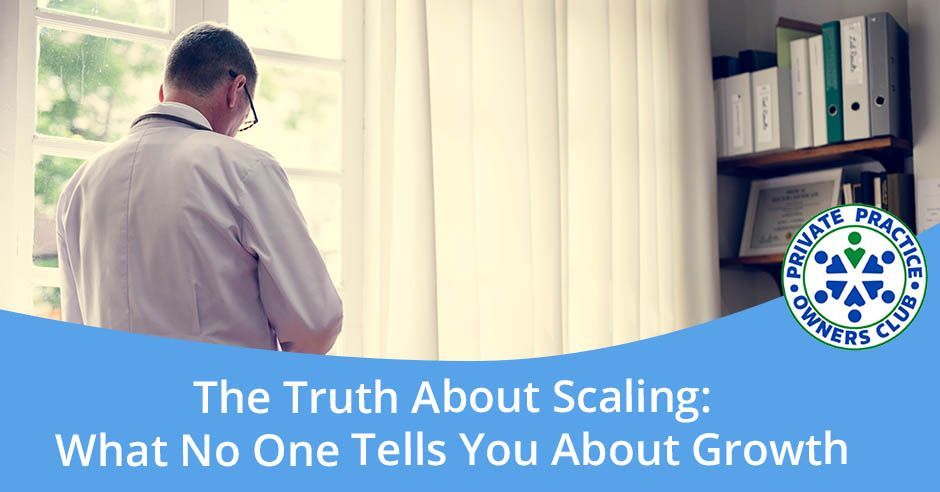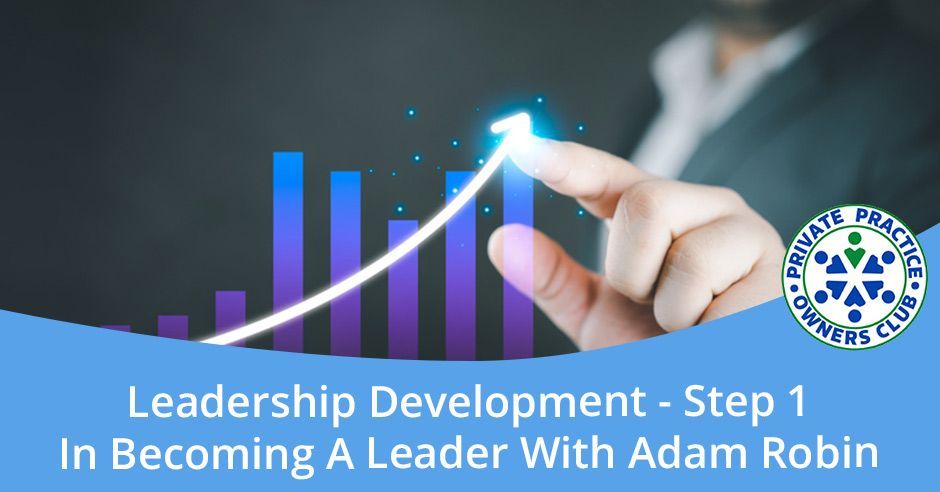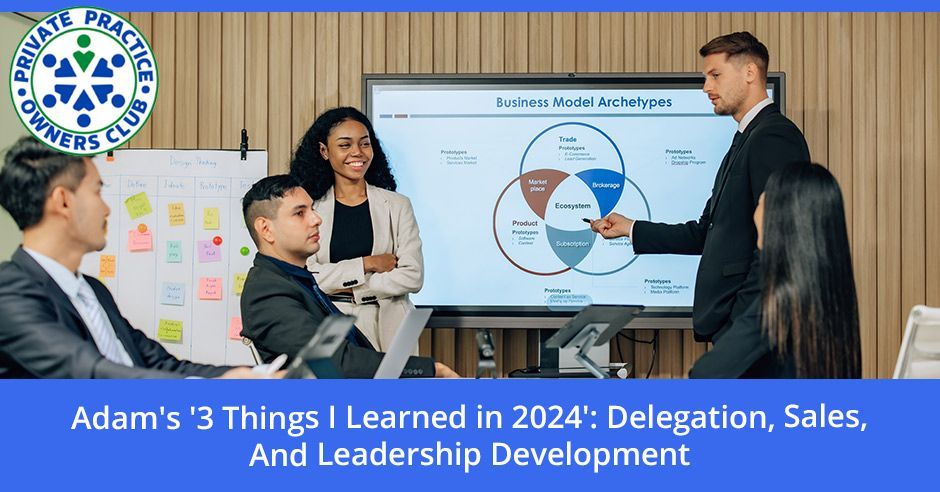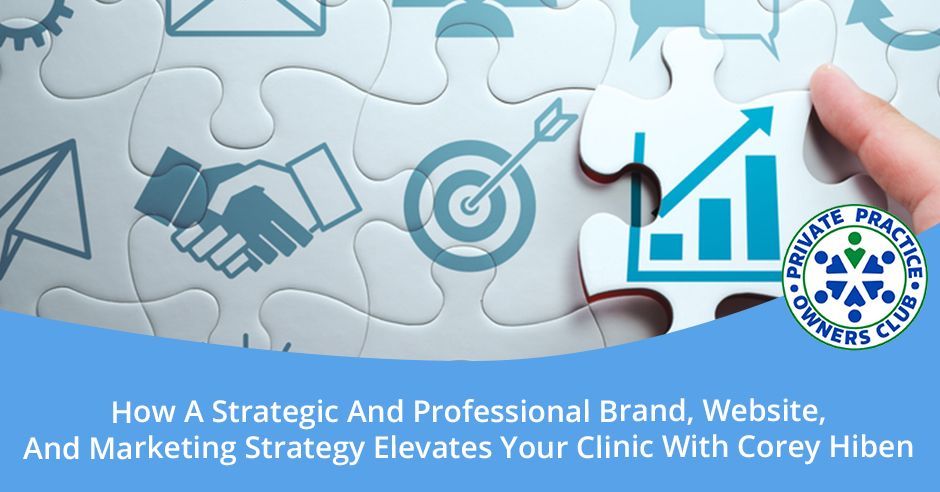In this episode of the Private Practice Owners Club Podcast, Nathan Shields and Adam Robin explore the importance of embracing a sales mindset and integrating it into your clinic’s core values. Learn how to transform "sales" into a valuable tool for advancing your clinic's mission and serving a greater number of patients.
Sales is not just about closing deals; it's about ensuring patients receive the care they require. Nathan and Adam illustrate how every interaction, be it at the front desk or in the clinic, entails some level of sales. Altering your view of sales can positively impact your practice. If you have faith in the value of your services, it is your duty to effectively present them.
Adam introduces the "Purpose-Driven Provider Program," focusing on aligning your team around the shared goal of patient care, without the negative connotations of sales. Adam and Nathan also outline the patient journey, from the first phone call to follow-up visits, and emphasize the importance of scripting and standardizing touchpoints to ensure clarity and purpose.
Want to talk about how we can help you with your Private Practice business, or have a question you want to ask? Book a call with Adam -
https://calendly.com/adamrobin/dr-adam-s-30-minute-connection
---
Listen to the podcast here
Practice Owners Manual Series, Part 5 - Clinical Sales: The Purpose Driven Provider Program With Adam Robin
Welcome back to the next episode in our series of the Quintessential Bulletproof Practice Owner’s Manual for Success. Hopefully you appreciated the previous episode, took lots of notes, and did some homework. Now, get ready to do some more work on your business. Get a pen and paper, and let’s go.
---
Welcome back to the show. I am Nathan Shields and I got my partner
Adam Robin on with me. How you doing?
What’s up? I’m doing great.
We’ve recorded four episodes so far regarding building out the perfect practice manual. I’m excited about what we put together so far. We went through the foundation of creating your initial entity, your habits for time management and focus, financial mastery and the four bucket marketing system. This is our fifth one.
It is going to be a little bit higher level stuff again, but important to implement into the company because it’s all about sales. I hate to talk about sales because I know all physical therapists they cringe like, “I want to be salesy. I don’t want to do sales,” but you have to. If you’re a physical therapist, you’re selling a plan of care.
If you’re not selling a plan of care, you’re not fulfilling your purpose as a physical therapist. There’s sales throughout the organization. The front desk has to get people in the door to arrive at their visit and there’s some sales process going in there. Long story short, part five is all about clinical sales. What do you want to say about clinical sales, Adam?
You’re selling every day. Nathan, what’s your favorite place to eat?
I’m a Thai food fan, so I don’t have a specific place but if it’s a good Thai food I’m happy.
What do you like about Thai food?
I love the flavors. It’s filling. It also feels fresh.
Are you selling me on Thai food now?
No, I’m not.
You are.
I am. This is why it’s great.
You sell every day. If you’ve ever sent out a birthday card, you’re selling people on the idea to come to your birthday. If you ever convinced anybody like, “We should go on a double date and go watch a movie. I would love for you to come to this concert with me. It would be fun time.” You’re selling the concert for free.
Section One: Mindset, Beliefs, And Definition Of Sales
It’s because you believe that this would be a valuable thing that we could do together. I believe in this product. I believe in this thing. It’s worth considering because it’s going to be impactful. It’s going to be fun. The first part of sales is to create the right mindset around it. The first person that you’re going to sell is yourself. You have to ask yourself, do you believe in what you do? Do you truly believe that physical therapy, occupational therapy, or speech theraphy or whatever it is that you do is beneficial to the patient you work with? Are you trying to transform their life?
The first part of sales is to create the right mindset around it.
If the answer is yes then you have an obligation to try to help them in any way that you possibly can. Part of that process is to help orient them to what you do and identify how you can help them and plug your plug your service in as a solution to help them get what they want. That’s all that sales is. It’s not manipulation or trying to trick you. It’s, I want to help you and I’m very committed to that.
We’re talking about clinical sales but it’s Clinical Sales: The Purpose Driven Provider Program and that’s the name that you give in your clinic. What’s cool about is it doesn’t say sales in it but it talks about purpose. As I said, like it gave the example, if the front desk is going to live out their purpose to a great extent. They are going to sell the idea to that person on the phone that they need to come in for physical therapy at the time that they scheduled for it and they shouldn’t cancel or they need to reschedule and come in at the frequency that they should come in at.
There is a sales process going on but it’s all about how they are living out their purpose at the front desk. It’s the same thing with provider. We don’t talk about it as sales when we’re talking about the plan of care that we’re coming up with initial evaluation situation. It is fulfilling our purpose to be successful in getting results with patients.
That’s our job as physical therapist. It is to help as many people as possible as much as possible and we do have to “sell our services” during that plan of care presentation so that they come in and get the results that you know you can get them. It goes further on and we’ll talk about over the course of this episode.
I like that you gave it the name of the Purpose Driven Provider Program. It doesn’t use the word sales in it to, hopefully, not trigger anyone who’s said about potentially selling stuff. It’s helping the clinic and the team members within the clinic remember this is helping us drive the purpose of not only our individual positions, but the purpose of the organization.
Our organization is built to help as much as possible to as many people as possible to get the best results the most results from all of the patients that are in our community. If we’re doing that at a high level then everyone wins. I love that you tie it back to purpose and being purpose driven in the title of it.
It’s not the trick people into giving you money for no reason program. It’s not the bee on ethical and try to steal people’s money when they’re not looking program. We’re trying to serve massively. The way that we communicate and the way that we align everybody around our purpose and our mission and the impact that we’re trying to make and people’s lives. Part of building a great culture is sharing a language of service.
We need to communicate that we are here to help and we truly want to help you. That’s all part of what the sales process says. By the way, sales also means helping people realize that maybe we’re not the best fit for them. It’s not only about trying to get the sale and try to get that and try to help people. It’s also trying to help people realize that, “Maybe this isn’t a good fit or this isn’t the right place for you. Maybe you need an X-ray. Maybe what we’re doing here is not the best thing for you.” That’s a very much a part of the program.
At that point, it is not sales but it is closer to driving our purpose. Where do you start with this? How do you develop your purpose driven provider program so that every member on your team recognizes their part in the “sales process?”
Step one like we mentioned is always the mindset. There’s mindset around sales, marketing, recruiting, KPIs, and production. The first thing to do is define it, what is sales? What is it? How do you define sales? What are some of the ways that you can align your team around sharing some language around what sales is and what it isn’t? What do you want to be known for around sales? How are you committed specifically? How are you committed to helping people?
More importantly, how strongly do you believe that what you do can help people? There’s some common language that you’ll want to build around that with your team. There may be a few books that you want to have reference in that. Creating a an agreement with your team of around what sales is the foundation of the program.
Since you brought it up, the definition of sale is the exchange of commodity for money, the action of selling something. We’re talking about an exchange. You want to set that up with the people that you’re working with and how that exchange is happening at each interaction.
That sounds great. Another way to define it is sales is serving others so that we can help them realize what’s most important to them and what they want then enrolling in the idea of taking action towards it whether that’s with us or without us. That’s what sales is in our practice and in our program.
Section Two: Developing A Framework Around Sales
You’re casting a vision out there and hopefully, defining it well enough so that they all so can see the vision for what it is then inviting them to buy into that and working together to achieve that vision. That’s another way of defining it.
We didn’t mention but in your notebook that you have, you got your notebook and a piece of paper at the top.
This is page five of the notebook.
It’s clinical sales program, the purpose driven provider program. Step one is the sales definition. What is sales? It might be worth picking up a sales book or two, educating yourself on what that is and what it isn’t so you can orient yourself to the sales world. You can put some language around that that is specific to your company then you can share that with your team. Start having conversations like that with your team during your team meetings. That’s what you should have right at the top sales, what is sales? What does it do? What do we meant to do? What’s our purpose? That’s a big part of it.
Revisit the purpose conversation as well. If we are able to attract more people or get more buy-in from more people into our organization what we’re here to do, will that be good for us? How would that affect our business if we got more people to commit to the idea of physical therapy and showing up all the time? Would that be good for us? Can we do better at that?
Can we help more people?
Speaking of books, are there any in particular that you came across that you like?
The one that comes to mind is
Sell or Be Sold by Grant Cardone. Grant Cardone is a controversial figure but he’s written up. That’s a fantastic book that outlines the importance of selling yourself first. Helping you realize that the most important person that you can sell is yourself and if you don’t believe in what you’re doing, you’re never going to make the impact that you want to make. When you start to establish in that mindset and establishing that belief in your company, that’s a powerful book to help you with that.
If you don't believe in what you're doing, you're never going to make the impact that you really want to make.
I have a book and it’s
Building a StoryBrand by Donald Miller. It talks a little bit more about branding. It also helps you recognize what people are looking for and in this case, patients clients are looking for is they’re not looking for a hero. I love that he lays this out in the first part of the book. They’re not looking for a hero. They’re looking for a guide because each of us are living our own heroes journey if you will. We are the heroes of our own story. What we’re looking for is a yoda or a sensei to guide us and direct us and the Obi-Wan we but we’re the hero of the story. We’re not looking for the hero to come and slay the dragon for us. We want to be the ones this lady the dragon.
I say this because I haven’t read a lot of sales books but this is the one that might approximate that the most. It’s
Building a StoryBrand and you can look at a website. If it’s all about, “We’re the best. We have all these certifications. This is why you need to come see us because we’re cooler and better. We provide hands-on manual care.” Which every other therapist says, but they’re not looking for that. They’re looking for, “You’re not talking about my pain points and what I’m looking for. You’re talking all about yourself.” Long story short,
Building a StoryBrand was a book by Donald Miller that I appreciated regarding sales.
Section Three: Mapping Out The Patient Life Cycle
We alluded to this slightly in the last episode, but the next section of your manual is going to be building out that patient life cycle inside your practice and understanding what the experience is for your patients when they come in. If patients have that first phone call with you or you could even you could even back it up to the website, but that first “physical” touch point there is going to be that that phone call.
They’re communicating with you with somebody who’s representing your organization. It’s important that we have some very distinct language that we choose to use during that call because as you said, we’re not the heroes. We want them to feel like the hero. We want them to feel understood, get clear on like what’s important to them, and how we might be able to serve them.
There’s an outcome that we’re looking for in that call. Part of that outcome is going to be, what are they want? Can we help them? Are they scheduling an appointment with us? That’s the goal. That’s the intention and the only thing that you can do to manipulate or control that outcome is the way that you speak to them. Having some very clear scripting around like what your front office is saying during that call is important.
This patient experience lifecycle is something that I’ve laid out in the past. It was a number of years ago where I went through it by myself, but each person can do it themselves. I’d recommend they do it and not just look for someone else who’s already done it because it doesn’t take a long time. Imagine at what points are we interacting with the potential patient, the patient, and the discharge patient all along till they’re balances finished at zero.
Even after zero is past patient experience. I don’t know about you but I think I counted thirteen touch points there. I included maybe the website, but after that was the phone call, the first visit, then each subsequent follow-up visit, progress report visit, and discharge visit. You name it all the way through billing collections and balance paid off. Maybe I’m over speaking it.
A great exercise to go through and what we’ve done in the past and what you’re using the same model for, what we’ve done in the past was how can we better show our values at these touch points? This is something that honestly, I did a episode with Jerry Durham a few years ago all about the patient experience. We talked all about how can we improve the patient experience by showing our values better? How can we make it better for the patient? How can they feel our values being lived through this touch point at each point?
What you’re saying is using the same time frame, the same life cycle to say, how can we improve our sales? How can we better show our purpose at this point? You’re going back to, what is the result from this that we want to see? At that initial phone call, what’s the what’s the ideal outcome for that? What language do we need to use in order to achieve that?
To speak specifically to that first phone call, it drove me crazy when I didn’t have my crap together and people were calling and asking, “Do you accept such and such insurance?” My front desk person would say, “We do.” They’re like, “Great.” I go, “No.” You lost an opportunity. They’re not just window shopping.
I’ve had interviews with sturdy McKee and he was like, “The first question now that front patient care providers were mouths should not be like, “Let me get you in the system. What’s your name? What’s your date of birth?” This should be a conversation about what are you looking for? What’s your problem? Talk to me a little bit and see if we can help. What would be an ideal situation or have you had physical therapy in the past? What’s worked for you? What hasn’t worked for you? This is what we do and what body part are you working on? That stuff what would go along way and that one touch point can say a lot about the clinic for the person who’s calling in. It’s how they’re being treated during that first phone call. It’s invaluable to nail that part.
Nailing that initial phone interaction is crucial, as it sets the tone for the patient's experience.
What helps me wrap my head around it is, we and when I say we, our team. Me as the owner and my team. We’re going to take 100% ownership of that experience. We’re going to create an environment that we want to create. When people call our clinic, we want them to be like, “I can tell very quickly I’m on the phone with Southern Physical Therapy Clinic because they’re doing things in a very unique way.” It’s not just like another random office that they’re recalling.
We are like, how do we want them to feel? What do we want to make sure we communicate? How can we help them better? We’re going to take ownership of how they feel and how they interpret. We’re responsible for the interpretation. We’re 100% responsible, so get granular in there and make sure that you’re taking ownership there and make it good. If you make it good, you’ll get great outcomes and your patients will be super happy.
I’ve talked to Dee Bills a number of times on the show and that first interaction of the front desk. It ends up being the last interaction as they walk out the door can frame the entire experience. You can do magic behind the scenes as far as the therapy goes. If they have a poor experience there at the front desk and before or after care, that could totally frame the entire experience right there. No matter how good you are.
On your paper, you’ve got initial phone call, how do we want them to feel, what’s the product of that phone call, what’s the scripting that we want to make sure we cover and what’s the outcome we’re looking for? Build that into your practice. Standardize it. Train your front desk on it.
This is what we say. This is how we address this question.
This is how we say it. This is our purpose.
Here are some FAQs. Be prepared to hand it to them.
They’re probably are thirteen but what we’re going to do is go through six. We’ll do six big touch points. The second touch point there is going to be the intake process. We all know about that intake paperwork. If I had to guess, there’s probably some important information that you would want the patient to understand during that intake process.
You want to be very clear about what’s expected, owed, and what they can expect from us, how to behave here and how not to behave here. You also want to give them clarity on like, “This is what you wear when you come to therapy. This is going to be your therapist. You’re going to be here for an hour.” The intake process is important because that’s a big place where you get to educate your patient.
When you can pour into them at that touch point and provide them with massive amounts of education and serve them at a high level. The amount of confusion that they have during their stay with you is going to be it’s going to be a lot lower. When they’re not confused, they’re able to sit there and relax and get served by your clinicians. That intake process is important.
It’s huge and you can imagine that it’s similar to onboarding and a team member to your team that I I know you do this because I’ve seen you do it. That is, this is what it looks like to have a successful physical therapy experience and educating that them on that. If you’re front desk is giving them a taste of what they’re going to hear at the initial evaluation, that’s going to be super strong and that this is what it this is how you can guarantee greater results or best results from physical therapy and that is you’re going to come at the frequency that you’re supposed to come at.
You’re going to give them updates on the things that you’ve done, you haven’t done, and how are you feeling at that time. You’re going to come and complete the entire prescription or plan of care that the therapist provides for you. People who do this, who come at that frequency, communicate well with their providers and come for the full plan of care are 60% more likely to be successful in the results that they get from physical therapy.
If they can hear that from a non-provider and that is doubled down with. It’s not the first time that they hear it when the provider says that to them at the initially evaluation. It could be huge. I think stacking the same verbiage on top of each other hits it home to the patient as they’re coming in the door. Having the front desk person talk to them about what successful experience looks like van be great. They might even have to remind them as they’re coming back out of the initial evaluation to schedule their appointments.
Remember, we want you to come into the frequency. What was the frequency that they recommended? We to get the best results and the maximum results. You’re going to want to come at that frequency for that period of time. Having that language can all help at the front desk to prepare the patient to buy in to whatever the physical therapist is about to present to them.
You’re teeing it up like, are there any questions? Is there any confusion? How can we support you here? You do that well. You serve them. They come in and I’m super clear like where I’m at, who these people are, what’s expected of me and what I can expect. I am just so prepared. The next touch point is the initially evaluation. At that point, that patient is handed off to the clinician. Everybody that’s an owner, you have your secret sauce way of delivering the initially evaluation. You’re going to have your SOAP or set some goals. You’re going to do your PT thing, but you’re also going to communicate in a way that’s very specific to you.
You want to make sure that you’re listening in a way that’s very unique so that you can capture them information that’s important to you. You want to make sure that you communicate specific things during that eval to make sure that you’re managing any questions or any confusion that they have. You want to make sure that person is fully served and supported. They feel heard and there’s a lot of trust built. There’s a way of doing this that you have inside your head.
A lot of challenges I see with younger owners is they have a hard time letting go of this to other providers because they don’t have this documented. They don’t have this systemized yet because they’re so concerned about like, “I want to make sure that this PT is delivering maximum quality like I do.” The way to do that, the solution is that is to get this out of your head and to get it on paper.
It’s like, what is your subjective? What do you say? Why do you say it that way? What are you hoping to achieve there? What outcome are you looking for? What is your objective look like? How long does it take? How many special tests do you do? Why? How do you set goals? How do you close it? How do you solidify that buy-in? When you can outline that during the initially evaluation with some loose scripts and some ideal outcomes and questions that are important to you and you can train your team on that. You can develop a consistent product for your patience. That initial evaluation is huge brain of practice.
This was a real hard point for me to understand and finally come around to. I had a coach decade plus ago telling me the same thing. She said, “You need to videotape your initially evaluation and see what you do you uniquely well because I don’t think I’m alone. You’re in the same boat. The owner of the practice typically has the best productivity numbers. Am I wrong?
You probably have the best arrival rate and have the patience that come at the best average frequency. They probably come for the longest period of time because they’ve bought into you. The reason why it was a hard thing for me, it was a real sticking point was because I didn’t think that anything I was doing was very uniquely different than anyone else because it comes second nature to me. This is how it’s done. Isn’t this how everybody does it?
I had that attitude as I was bringing on other providers and they didn’t have the same productivity stats that I do. It’s like, “What do are you guys doing? Are we all not doing the same thing here?” No, we weren’t because they weren’t me and I didn’t train them on what it was that I did to get those engagement numbers. As you said, having some loose script is important, especially if you’re at a smaller scale where there’s maybe 1 to 3providers including yourself.
Another way to do this was something that I did with Tom Dalonzo-Baker shared because he had the experience where he was bringing on these other providers. We’re referring patients over to his practice and telling patients, “You need to go see Tom.” When they came to the practice, they were expecting to see Tom and not the other providers. He wasn’t able to get separation from him and his therapists in the doctors minds. Everyone experiences this to some extent.
What he did is he got his team together and this was over the course of many weeks and months. They decided that they were going to have a standard way of doing things across their practice during initially evaluation and specific to each major body part. This is the home exercise program that we’re going to all agree for the knee and the back and all that stuff. We’re going to figure that out so this is standardized. We come to agreement. This is our protocol. Very rare exceptions you go off of the protocol.
You can add some things to it but this is our basic standard care for each of these according to our practice. That way when someone gets referred over from the physician, it’s not just Tom who’s providing unique care that no other provider can provide but Tom and everyone else is going to provide pretty much the same care. To your point, they’re going to use some of the same verbiage. They’re going to agree that we’re a three-time a week clinic or with these cases, we are two times a week or they’re going to have some agreement some standard of care to the practice.
That can go a long way especially if you’re looking to expand. If you want to stay a small practice, it might not matter too much especially if each provider has a unique specialty. If you want to have more than a couple of providers all providing the same niche of care and want to go beyond the clinic to maybe a second or third clinic.
That standard of care and the verbiage that you’re talking about having that script is vital. I don’t want to make it sound cheap but you want to have the McDonald’s experience where it’s systematized. We know we can punch patients in and get these results because we’re all saying these scripts using these scripts or using the same recipe if you will.
If you care about your patients and your team, you just got to do this. This is a massive way to serve them each. You’re giving your team so many tools and you’re giving your patients this amazing experience. I have seen new grads that we’ve hired two months into to their training. They look like seasoned rock stars because they’re so trained.
If you really care about your patients and your team, you have to figure out ways to serve them. Equip your team with the tools they need and provide your patients with an amazing experience.
They’re so trained on how we do things and they’re so bought in. It’s like confident, secure, powerful, then you walk in the clinic and I haven’t been to the clinic in two months. The patients are like, “Adam, I want to say, you’re therapist are amazing. I cannot tell you how much. They are amazing. I don’t know what you guys do here.” I’m like, “I know what we do here.” It’s incredible. It’s a valuable thing.
If you’re talking about the patient experience, I know we’re talking about the initially evaluation here, but in general, I have had coaching clients in the past that say, “My patients and my providers love it here. I don’t know what it is that brings people back.” The exercise I gave them was asked the patients. What are why do the patients love being here? What did they notice? Why did they come across town to come and see you or even ask the providers, what do you guys think? What do we do differently here? You’ve worked in other practices, what do we do differently here that makes you happy and makes the patients happy?
When you get some of those answers, see if there’s any way you can automate it and systematized it to to keep it going so it doesn’t fall out. In that instance, they did maybe once a quarter, they all agreed on a charity that they were going to work with. Whether it was doing a 5K or a food drive or you name it.
That was their team building experience for the providers. When the patients came in, everyone knew their name. They called them by the first name, “Hello.” For us, we had a whiteboard and we put the little of the day or the joke or the trivia of the day. We had TVs. I know in Will’s clinic at 10:00 AM, they’re going to watch the Prices is Right while they’re doing their therapy.
If 10:00 AM came around, even the patients would be like, “It’s 10:00 AM. Where’s the Price is Right?” They’d answer some of the questions and stuff. All of that was systematized. There was going to be someone in charge of putting the riddle of the day up on the whiteboard. There was going to be someone in charge of finding the charity for the next quarter and making sure that everyone was bought in. Those are all things that need to be systematized. I’m going past the eval a little bit here, but to the greater patient experience, these are all things that need to be dialed in.
We’ve got the initial phone call valid in, intake process, initial evaluation.
I consider those two different things.
What’s that?
The initial intake at the front desk then the initial eval.
For sure.
A couple things in between there, what about your confirmation call before the initially eval? I only bring that up because that’s how I got to thirteen. There’s all so the confirmation calls, the email that you send like, “I hope your first visit was good. If you have any questions, make sure you contact, blank. Your home exercise program is important.” That’s like a formulated templated thing that goes out. Those were also touch points and that’s how I got to thirteen.
I’m going to do two. The next two in a row is going to be similar. You’re going to have the check-in or the progress note.
I also had a simple one for the daily visit.
Correct. You’ll have your daily follow-ups.
What is the subsequent regular visit going to look like? That’s another touch point but let’s move forward to the progress report.
You’re going to have the big touchpoint of the check-in. It’s almost like the re-eval. It’s like, “Let’s see how you’re doing. What’s up? What’s going on here?” The next major touch point after that would be the dish charge. The mistake that we make or I’ve made is we treat the progress note and the discharge like a daily note. It’s like, “Nathan, come on in. Let me take some range of motion. Jump on the bike. Let’s get going.” No. Have a conversation with the patient.
Make sure we’re asking them like, “What’s your experience like with us? How are things going here? I’m curious, Nathan, from 0 to 10, how would you rate your experience with us? Are we hitting a home run or are we hitting a single or a double? Is there anything we can do to get better here? Are we satisfying your needs?” Here’s another great question, “Would you be willing to refer a friend or family member to us?” Probably a pretty cool question.
If I have a progress note with a patient, I would I would expect that my therapist would have a sit down and look this patient in the eye and review their progress like, “Are we getting home runs with you? what’s going on?” The same thing with the discharge. You’re going to have that touch point where it’s like, “These are all the things we’ve accomplished. Is there anything that we’re missing? Would you consider this a home run? Home runs, 10 out of 10. Fantastic. Would you be willing to leave us a review or a testimonial about your experience with us? Would you be willing to share your experience with your position that referred us?” All important things. Those two touch points are important as well.
They are super important because you want to highlight the progress that they’ve made. It’s our human nature to focus on what’s still left. I’m not where I want to be and because I’m not where I want to be, I’m upset about it, but we don’t recognize the gain that we made in the past. You want to highlight the gain you made in the past with the intervention that you provided like, “Look at these objective numbers. You were here and now you’re here. Here are these functional tasks that you can do that you couldn’t do before and to show the value that you’re providing.”
You have to retrain the patient to see the success that’s been achieved over that time. It’s important to have the conversation like you’re talking about simply because we are losing the battle if a patient is coming in and saying, “How much longer do we got?” If they’re saying that I’m assuming it’s coming from a place of, “I don’t know if I want to keep doing this.” It seems like there’s no end in sight.
You’re losing the battle if a patient comes in and says, “How much longer do we have?”
If you’re hearing that, I would say that you’re probably failing in the communication side of things as the provider because you’re not telling them where they are in the course of the care. If you’re having them come in and go, they do their thing and leave and not communicating. According to our expectations, you were probably about 40% of the way there or 50% of the way there.
You should be able to do that as a provider and say, “We agreed at the initial evaluation that you wanted these functional tasks. You can only do these functional tasks so far pain-free. We want to get you there and even further because you might regress after physical therapy. You’re only about 40% or 50% of the way there. Our initial plan was to have you come in for three weeks. At your current progress rate, we either need to see more frequently or we need to plan on seeing you an extra 2 to 3 weeks.” You need to have those conversations on a regular basis probably every visit because they’re they want to know where they’re at in terms of how much therapy they need.
This is why sales is important. This is a sales process. It’s like you helping them understand how and what they are doing is going to positively improve their life and help them get to what they want to do so they can understand the value and they can buy into the idea of doing it. Unless, they’re like, “I don’t want to do this.” That’s a different story. That’s part of what sales is, you’re helping them see why this is important,.
Very important touch points. You want to make sure that you’re capturing the buy-in and the positive testimonials there. The final one is the follow-up. The patients been gone. They’re discharged. Our thing is, once a patient always a patient. Once you step foot in our clinic, you become family. We’re going to call you.
Once a patient, always a patient. Once you step foot in our family, in our clinic, you become family.
There should be some. periodic touch points that you have with those patients after they leave your clinic. Ideally, they should be some phone calls. Not just phone calls but maybe some emails or some text messages, too. It’s like, “Mrs. Smith, how you doing? I hope you’re doing fantastic. Tell me a little bit about what’s going on in your life. How’s the shoulder? Is there anything I can do to support you?” There’s some communication there. That’s important. What are we trying to do here? How can we support them?
Sometimes, you’ll find that maybe there’s opportunities for you to serve them more. Maybe there’s a new issue that they’re dealing with. Perhaps, they have a family member that they want to refer to you. Worst case scenario, if none of that is true, maybe you could get to say, “I appreciate you. If there’s anything you need, we’d love to support you.” Show some gratitude to them. Having that follow up is important. You keep them in the life cycle and you can be there when they’re ready to be served.
This is where physical therapists can truly devolve into a commodity if it’s just one and done. We treat you for your knee and we never see you again. That’s when a patient later down the road is going to have a shoulder issue and they’re just going to go wherever the physician tells them. It’s with these follow-ups where you’re you act like the dentist.
Usually, when a person has a dentist, they have a dentist. They don’t bop around at different dentists all the time. They want to stick with one, and this is how you avoid becoming a commodity and become that patient’s physical therapist or that family’s physical therapist hopefully for life. That’s how you do it, you maintain communication. You say, “How are you doing? How’s the puppy? I’m sure it’s full grown now. Super fun. How’s the vacation to Italy? Anything else going on that we can help you out with? Are you doing okay? How’s the family?” That’s how we maintain that that place in their lives and they know, like, and trust us. When they have something else come up, they’re going to come back and see us and not wherever the doctor wants them to go.
Your final product is your piece of paper with the clinical sales or some type of name at the top. Section one is going to be your mindset, beliefs, and definitions of what sales is. You’re going to create some alignment with your team around what that is. Section two, maybe if a handful of books that are relevant that helped you and your team develop a framework around sales.
Section three is going to be mapping out that patient life cycle at minimum, initial phone call intake, initially evaluation, progress note, discharge, and follow up minimum and developing strategic language communication and outcomes that you’re looking for with those interactions and standardizing that across your clinic with all your providers.
I would add making sure their standardized communication from the billing collections team as well because sometimes we don’t we sometimes we think that they are outside of us, especially if they’re a third party, even if they’re in-house. You want to make sure their language is following in line with the values of the company because they’re a representative of you even if you’re hiring that out. You want to make sure that’s aligned and using the proper language.
Rock and roll.
Part five in the books. I don’t know even though if we’re halfway there.
We’re dropping so much value here.
There’s a lot more to come.
There’s so much more.
Stay tuned. Thanks again. We’ll see you next time on the show.
Have a good day.






